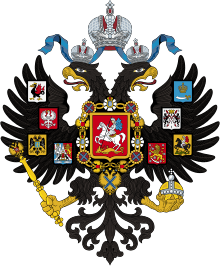Emperor of All Russia
The emperor or empress of All Russia or all the Russias (Russian: (pre 1918 orthography) Императоръ Всероссійскій, Императрица Всероссійская, (modern orthography) Император Всероссийский, Императрица Всероссийская, Imperator Vserossiyskiy, Imperatritsa Vserossiyskaya) was the absolute and later the constitutional monarch of the Russian Empire.
| Emperor of All Russia | |
|---|---|
| Император Всероссийский | |
Imperial | |
.svg.png) | |
 Last to reign: Nicholas II 1 November 1894 — 15 March 1917 | |
| Details | |
| Style | His/Her Imperial Majesty |
| First monarch | Peter I |
| Last monarch | Nicholas II |
| Formation | 2 November 1721 |
| Abolition | 15 March 1917 |
| Residence | Winter Palace |
| Appointer | Hereditary |
| Pretender(s) | Disputed: Maria Vladimirovna Andrew Romanov Prince Karl Emich of Leiningen |
The title originated in connection with Russia's victory in the Great Northern War of 1700–1721 and appeared as the adaptation of the tsar's title under the accepted system of titling in Europe. The suffix "of All Russia" was transformed from the previous version "(Tsar) of All Rus'".
Title
Article 1 of the Fundamental Laws of the Russian Empire stated that "the Emperor of All Russia is an autocratic and unrestricted monarch. To obey his supreme authority, not only out of fear but out of conscience as well, God himself commands".[1]
The full title of the emperor in the 20th century (Art.37 of the Fundamental Laws) was:
By the Grace of God, We, NN, Emperor and Autocrat of All the Russias, Moscow, Kiev, Vladimir, Novgorod; Tsar of Kazan, Tsar of Astrakhan, Tsar of Poland, Tsar of Siberia, Tsar of Chersonese Taurian, Tsar of Georgia; Lord of Pskov and Grand Prince of Smolensk, Lithuania, Volhynia, Podolia, Finland; Prince of Estland, Livland, Courland, Semigalia, Samogitia, Belostok, Karelia, Tver, Yugorsky land, Perm, Vyatka, Bolgar and others; Lord and Grand Prince of Nizhny Novgorod, Chernigov, Ryazan, Polotsk, Rostov, Yaroslavl, Belozersk, Udorsky land, Obdorsk, Kondia, Vitebsk, Mstislav, and all of the northern countries Master; and Lord of Iberia, Kartli, and Kabardia lands and Armenian provinces; hereditary Sovereign and ruler of the Circassian and Mountainous Princes and of others; Lord of Turkestan; Heir of Norway; Duke of Schleswig-Holstein, Stormarn, Dithmarschen, and Oldenburg, and others, and others, and others.[2]
Tsarist autocracy
The person of the tsar himself, a sovereign with absolute authority, stood at the center of the tsarist autocracy.[3] The rights of state power in their entire extent belonged to the tsar. The autocrat further entrusted power to persons and institutions, acting in his name, by his orders, and within the limits laid down for them by law. The purpose of the system was to supposedly benefit the entire country of Russia.[3] A metaphor existed likening the tsar to a father, and all of the subjects of the Empire, to his children; this metaphor even appeared in Orthodox primers.[4] This metaphor is present in the common Russian expression "царь-батюшка", literally "tsar-dear father".
Furthermore, unlike the future theoretical separation of church and state in West European monarchies, the Russian Empire combined monarchy with the supreme authority on religious issues (see Church reform of Peter I and caesaropapism for details).
Another key feature related to patrimonialism. In Russia the tsar owned a much higher proportion of the state (lands, enterprises, etc.) than did Western monarchs.[5][6][7][8][9][10]
The tsarist autocracy had many supporters within Russia. Major Russian advocates and theorists of the autocracy included writer Fyodor Dostoyevsky,[11][12] Mikhail Katkov,[13] Konstantin Aksakov,[14] Nikolay Karamzin,[12] Konstantin Pobedonostsev[11][3] and Pyotr Semyonov. They all argued that a strong and prosperous Russia needed a strong tsar, and that philosophies of republicanism and liberal democracy did not fit Russia.[11]
List of emperors
| Name | Lifespan | Reign start | Reign end | Notes | Family | Image |
|---|---|---|---|---|---|---|
Peter I
| 9 June 1672 – 8 February 1725 | as a tsar: 2 June 1682 as an emperor: 2 November 1721 | 8 February 1725 | Son of Alexis I and Natalya Naryshkina Younger brother of Sophia Alekseyevna, Feodor III and Ivan V He ruled jointly with Ivan V Regarded as one of the greatest Russian monarchs | Romanov | 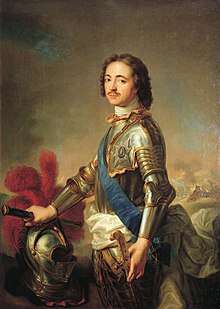 |
Catherine I
| 15 April 1684 – 17 May 1727 | 8 February 1725 | 17 May 1727 | Wife of Peter I | Skowroński | 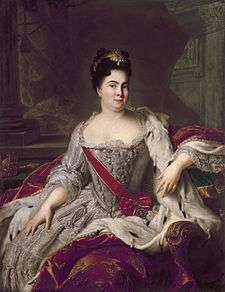 |
Peter II
| 23 October 1715 – 30 January 1730 | 18 May 1727 | 30 January 1730 | Grandson of Peter I via the murdered Tsesarevich Alexei. Last of the direct male Romanov line. | Romanov | .jpg) |
Anna
| 7 February 1693 – 28 October 1740 | 13 February 1730 | 28 October 1740 | Daughter of Ivan V | Romanov | .jpg) |
Ivan VI
| 23 August 1740 – 16 July 1764 | 28 October 1740 | 6 December 1741 | Great-grandson of Ivan V Deposed as a baby , imprisoned and later murdered | Brunswick-Bevern | .jpg) |
Elizabeth
| 29 December 1709 – 5 January 1762 | 6 December 1741 | 5 January 1762 | Daughter of Peter I and Catherine I, usurped the throne. | Romanov | 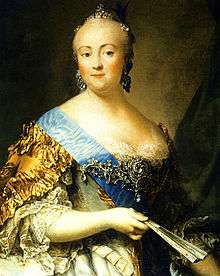 |
Peter III
| 21 February 1728 – 17 July 1762 | 9 January 1762 | 9 July 1762 | Grandson of Peter I Nephew of Elizabeth Murdered | Holstein-Gottorp-Romanov | |
Catherine II
| 2 May 1729 – 17 November 1796 | 9 July 1762 | 17 November 1796 | Wife of Peter III | Ascania | .jpg) |
Paul I
| 1 October 1754 – 23 March 1801 | 17 November 1796 | 23 March 1801 | Son of Peter III and Catherine II Assassinated | Holstein-Gottorp-Romanov |  |
Alexander I
| 23 December 1777 – 1 December 1825 | 23 March 1801 | 1 December 1825 | Son of Paul I and Sophie Dorothea of Württemberg First Romanov King of Poland and Grand Prince of Finland | Holstein-Gottorp-Romanov | .jpg) |
Nicholas I
| 6 July 1796 – 2 March 1855 | 1 December 1825 | 2 March 1855 | Son of Paul I and Sophie Dorothea of Württemberg Younger brother of Alexander I and Constantine Pavlovich | Holstein-Gottorp-Romanov |  |
Alexander II
| 29 April 1818 – 13 March 1881 | 2 March 1855 | 13 March 1881 | Son of Nicholas I and Alexandra Feodrovna Nephew of Alexander I Assassinated | Holstein-Gottorp-Romanov | .jpg) |
Alexander III
| 10 March 1845 – 1 November 1894 | 13 March 1881 | 1 November 1894 | Son of Alexander II and Maria Alexandrovna | Holstein-Gottorp-Romanov | .jpg) |
Nicholas II
| 18 May 1868 – 17 July 1918 | 1 November 1894 | 15 March 1917 | Son of Alexander III and Maria Feodorovna Abdicated the throne during the February Revolution Executed by the Bolsheviks | Holstein-Gottorp-Romanov |  |
Nicholas II abdicated in favour of his brother, Grand Duke Michael Alexandrovich, but the next day, after a nominal reign of only 18 hours, "Emperor Michael II" declined power, ending dynastic rule in Russia forever.
See List of leaders of Russia for the continuation of leadership.
History
The title of the Emperor of All Russia was introduced to Peter the Great. After the victory at the Great Northern War and signing the Treaty of Nystad, in September 1721 Senate and Synod decided to award Peter with the title of the Emperor of All Russia with the following statement: "in the manner of the Roman Senate for the noble cause of emperors such titles publicly given them as a gift and into statues for the everlasting generations inscribed".
On this 20th day of October, after a consultation of the Senate together with the Holy Synod accepted the intention, to his majesty, in the testimony of a proper gratitude for his high grace and paternalism and effort which he for the welfare of state in all his glorious time of ruling and especially during the past Swedish War, deigned to manifest, and all-Russian state in such a strong and good fortune, and his people subjected to such fame over the whole world through his unique ruling led, as that to all quite known, by the name of all the Russian people to ask, so graciously to accept, following the example of others, from them title: the Father of the Fatherland, the Emperor of All Russia, Peter the Great ...
— Laws of the Russian Empire at Large. Vol.VI. No.3840
On November 2, 1721 Peter I accepted the title. The Dutch Republic and Kingdom of Prussia immediately recognized the new title of the Russian Tsar, followed by the Kingdom of Sweden in 1723, the Ottoman Empire in 1739, the British Empire and the Austrian Empire in 1742, French Empire and the Spanish Empire in 1745, and finally the Polish-Lithuanian Commonwealth in 1764. Since then the Russian State was referred to as the Russian Empire.
On February 16, 1722 Peter I issued the Decree of Succession by which he abolished the old custom of passing the throne to the direct descendants in the male line, but allowed the appointment of an heir through any decent person, at the will of the monarch.
Coronation ceremony
Coronations in the Russian Empire involved a highly developed religious ceremony in which the Emperor was crowned and invested with regalia, then anointed with chrism and formally blessed by the church to commence his reign. Although rulers of Muscovy had been crowned prior to the reign of Ivan III, their coronation rituals assumed overt Byzantine overtones as the result of the influence of Ivan's wife Sophia Paleologue, and the imperial ambitions of his grandson, Ivan IV.[15] The modern coronation, introducing "European-style" elements, replaced the previous "crowning" ceremony and was first used for Catherine I in 1724.[16][17] Since czarist Russia claimed to be the "Third Rome" and the replacement of Byzantium as the true Christian state,[18] the Russian rite was designed to link its rulers and prerogatives to those of the so-called "Second Rome" (Constantinople).[19]
While months or even years could pass between the initial accession of the sovereign and the performance of this ritual, church policy held that the monarch must be anointed and crowned according to the Orthodox rite to have a successful tenure.[20] As the church and state were essentially one in Imperial Russia, this service invested the Tsars with political legitimacy; however, this was not its only intent. It was equally perceived as conferring a genuine spiritual benefit that mystically wedded sovereign to subjects, bestowing divine authority upon the new ruler. As such, it was similar in purpose to other European coronation ceremonies from the medieval era.
Even when the imperial capital was located at St. Petersburg (1713–1728, 1732–1917), Russian coronations were always held in Moscow at the Cathedral of the Dormition in the Kremlin. The last coronation service in Russia was held on 26 May 1896 for Nicholas II and his wife Alexandra Feodorovna, who would be the final Tsar and Tsaritsa of Russia. The Russian Imperial regalia survived the subsequent Russian Revolution and the Communist period, and are currently on exhibit in a museum at the Kremlin Armoury.
See also
- Church reform of Peter the Great
- Digest of Laws of the Russian Empire
- Government reform of Peter the Great
- Government reform of Alexander I
- His Imperial Majesty's Own Chancellery
- Imperial Crown of Russia
- Judicial system of the Russian Empire
- Most Holy Synod
- Patriarch of Moscow and all Rus'
- Pauline Laws
- Rulers of Russia family tree
- Russian Constitution of 1906
- State Council (Russian Empire)
- Table of Ranks
References
- "Chapter One On the Essence of Supreme Sovereign Power, Article 7." Archived 2018-09-05 at the Wayback Machine, Russian Imperial House: Official site of the Romanov Dynasty. Retrieved 26 June 2019.
- "On the Title of His Imperial Majesty and the State Coat of Arms", Russian Imperial House: Official site of the Romanov Dynasty. Retrieved 26 June 2019.
- Stephen J. Lee Russia and the USSR, 1855–1991: Autocracy and Dictatorship, Routledge, 2006. ISBN 0-415-33577-9, Google Print, p.1-3
- Robert D. Crews, For Prophet and Tsar: Islam and Empire in Russia and Central Asia, Harvard University Press, 2006, ISBN 0-674-02164-9, Google Print, p.77
- Deborah Goodwin, Matthew Midlane, Negotiation in International Conflict: Understanding Persuasion, Taylor & Francis, 2002, ISBN 0-7146-8193-8, Google Print, p.158
- Nicolas Spulber, Russia's Economic Transitions: From Late Tsarism to the New Millennium, Cambridge University Press, 2003, ISBN 0-521-81699-8, Google Print, p.27-28
- Reinhard Bendix, Max Weber: An Intellectual Portrait, University of California Press, 1977, ISBN 0-520-03194-6, Google Print, p.356-358
- Richard Pipes, Russian Conservatism and Its Critics: A Study in Political Culture, Yale University Press, 2007, ISBN 0-300-12269-1, Google Print, p.181
- Catherine J. Danks, Russian Politics and Society: An Introduction, Pearson Education, 2001, ISBN 0-582-47300-4, Google Print, p.21
- Stefan Hedlund, Russian Path Dependence: A People with a Troubled History, Routledge, 2005, ISBN 0-415-35400-5, Google Print, p.161
- James Patrick Scanlan, Dostoevsky the Thinker: A Philosophical Study, Cornell University Press, 2002, ISBN 0-8014-3994-9, Google Print, p.171-172
- Richard Pipes, Russian Conservatism and Its Critics: A Study in Political Culture, Yale University Press, 2007, ISBN 0-300-12269-1, Google Print, p.124
- Nicolai N. Petro, The Rebirth of Russian Democracy: An Interpretation of Political Culture, Harvard University Press, 1995, ISBN 0-674-75001-2, Google Print, p.90
- Muscovy, Sections "The Evolution of the Russian Aristocracy" and "Ivan IV". For crownings of earlier rulers of Muscovy, see Alfred Rambaugh Rambaud on the Rise of the Grand Princes of Moscow Archived 2012-02-06 at the Wayback Machine.
- Scenarios of Power. Princeton University Press.
- http://assumption-cathedral.kreml.ru/en-Us/history/view/tseremonii-i-obryady-v-uspenskom-sobore/
- Moscow the Third Rome. See also Moscow Becomes the Third Rome.
- Wortman, pg. 10. A political theory prevalent amongst many Orthodox Russians into the twentieth century postulated that there were three "Romes": the first (Rome) had allegedly apostatized from true Christianity after the Great Schism of 1054 between Roman Catholicism and Eastern Orthodoxy; the second (Constantinople) had equally apostatized by accepting Roman Catholicism at the Council of Florence and had subsequently fallen to the Turks; Moscow and "Holy Russia" were the third Rome, and (according to this doctrine) "a fourth there shall never be". A History of Russia, Chapter 1: Medieval Russia, Section "Ivan the Great".
- New York Times, May 31, 1896. Quoted in Wortman, Introduction. See also Blech, Annalise, The Russian Orthodox Church: History and Influence, University of Texas at Austin, 2008, pg. 9.
External links
- Excerpts from Statesman's Handbook for Russia. By the Chancery of the Committee of Ministers, St. Petersburg. 1896.
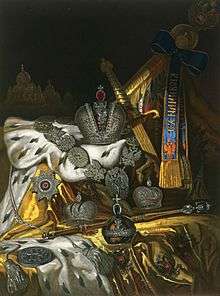
.svg.png)
.svg.png)
